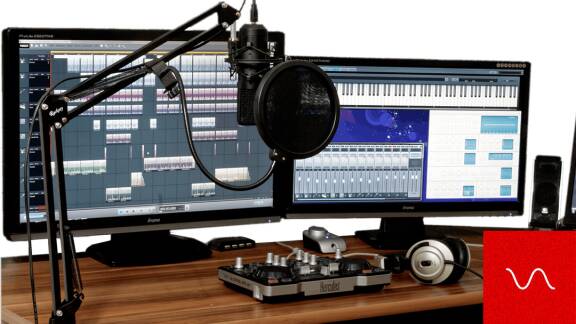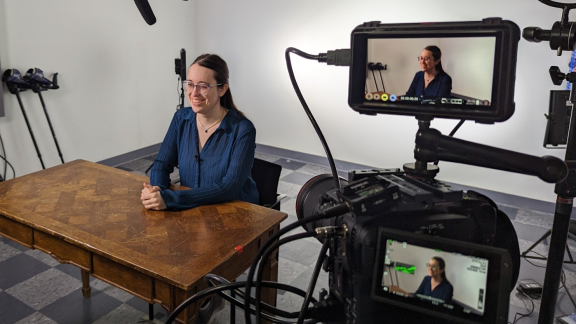NCAM works closely with our strategic partners to help them build internal accessibility expertise. We marry NCAM's research and development projects with the specific needs of each partner including digital television, rich media, convergent media, internet, e-commerce, e-books and other forms of media. We asked our partners to tell us why the program works for them, and how it is making a difference to their customers and employees with disabilities.

The Carl and Ruth Shapiro Family National Center for Accessible Media (NCAM) is a national leader in making digital media accessible for people with disabilities.
Established in 1991, NCAM is a research, development and consulting group that continues a half-century of ground-breaking media accessibility work at GBH.
Accessibility Consulting Services
Making any digital service or product accessible guarantees opportunities for organizations to broaden their reach, and to impact the largest possible audience of customers and users. NCAM partners with industries that recognize the need for accessible content, interactivity, and functionality throughout all stages of the digital experience.
Accessibility means something different for each industry, organization, audience, and product. With that in mind, NCAM tailors its services to meet a broad range of trends, needs, and expectations. Simply match your goals with one or more of NCAM’s services to learn about the accessibility possibilities.
Training
NCAM provides in-person and online training, offering a primer on how users with disabilities interact with technology and experience different media, and what it means to make that media accessible. NCAM will customize the training to your industry and your staff, vendors, clients, or user group by integrating your content and intellectual property into the training materials.
Evaluations
NCAM performs accessibility evaluations for websites, applications, software, hardware and all types of electronic documents for conformance with Section 508 regulations, state accessibility requirements and all levels of WCAG.
Standards and Regulations
NCAM participates in policy and standards-setting activities across a broad range of media-related areas, and has served as a technical resource to both industry and government.
CADET
CADET is free, downloadable caption-authoring software that enables anyone to produce high-quality caption files that are compatible with any media player that supports the display of captions. CADET can also be used to generate audio-description scripts.
Environmental Audio Description
Museums, theme parks, historic sites, national parks, and other locations provide environmental audio descriptions including audio described tours, events, and multimedia presentations. NCAM collaborates with clients on site visits, research, and unique delivery options.
As a content provider to academic institutions, we face an increasingly complex set of technical, legal, and instructional design considerations related to the accessibility of our content. NCAM has been indispensable in helping us understand and navigate this space.Denis Saulnier, Managing Director, Product Design and Delivery, Higher Education unit, Harvard Business Publishing
Impact
Accessibility means something different for each industry, organization, audience, and product. With that in mind, NCAM tailors its services to meet a broad range of trends, needs, and expectations.
Making any digital service or product accessible creates opportunities for your organization to broaden its reach, impacting the largest possible audience of customers and users. NCAM has partnered with industries that have recognized the need for accessible content, interactivity, and functionality throughout all stages of their customer’s unique digital experience.
NCAM's work has impacted dozens of industries, including the following:
- Academic publications
- Colleges and universities
- Electronics manufacturers
- Technology companies
- Online retailers
- Media producers, providers and broadcasters
- Local, state and government agencies
- Software, hardware and app developers
- Cultural institutions, amusement parks and stadiums
- Assessment, credentialing and certification organizations
- Law firms
- Airlines
People

The team in NCAM are inventors, implementers, and problem-solvers frequently anticipating and creating solutions for tomorrow's technology challenges.
Tools and Resources
Below are free resources available to the public. For more information about our consulting services and custom solutions, please contact us here.
- Accessible Designs for Personal Health Records
- CADET
- Captioning Solutions for Handheld Media and Mobile Devices
- TextStreamer
- Using HTML5 and Javascript to Deliver Text-Based Audio Descriptions
- Image Description Resources
- Accessible Online Learning: Personalized Access to NSDL, Teacher's Domain and Access for All Standards
- E-description: Extended and Enhanced Descriptions
- Specifications for Accessible Learning Technologies
- Access Symbols for closed captions, audio description, and more
Achievements and Standards
- 1996: US Patent #5,570,944, "Reflected display system for text of audiovisual performances"
- 2012: FCC Chairman's Award for Advancements in Accessibility: Media Access Mobile (MAM)
- 2015: US patent #8,892,447, "Quality assessment of text derived from an audio signal"
- 2016: Technical Emmy for co-authoring the W3C's Timed Text Markup Language (TTML).
- 2018: FCC Chairman’s Award for Advancements in Accessibility: Caption and Description Editing Tool ( CADET)
- 2018: Barry Levine Memorial Career Achievement Award (ACB/ADP)
- 1991-1998: Developed and released CC School, QuickCaption for Word and QuickCaption School, captioning software for use in classrooms.
- 1992: Launched MoPix, a project to research and develop ways of making movies in theaters accessible to deaf, hard of hearing, blind, and visually impaired people through closed captions and descriptive narration.
- 2000: Released MAGpie, the world's first free software for adding captions and audio descriptions to online multimedia.
- 2007: Developed CCforFlash, a free Flash component to display captions in Flash video and audio content.
- 2015: Created CC WebStreamer (aka TextStreamer) for repurposing broadcast caption data for online distribution, supporting both real-time and pre-produced captions.
- 2016: Developed CADET, a free browser-based tool for adding captions and audio descriptions to online video and audio.
- 2000: Created first-ever guidelines for accessible science and math educational software.
- 2000: Founded IMS Global Learning Consortium's Accessibility Working Group which led to the creation of the Access for All distributed learning standards.
- 2008: Published Effective Practices for Describing Images, for creating meaningful image descriptions textbooks and online materials.
- 2010: Co-established the DIAGRAM Center, along with Benetech and the U.S. Fund for DAISY, to research, develop and create tools, standards, guidelines and training to make it easier, cheaper, and faster to deploy accessible digital images.
- 2012: Published Describing Images for Enhanced Assessments
- 2012: Collaborated with IBM Research-Tokyo to research and develop methods of delivering text-based audio descriptions for online video.
- 2012: Prototyped solutions for delivering accessible supplemental materials alongside online video.
- 2015: Created a prototype accessible Personal Health Record system to demonstrate accessible health information technology
- 1997: Founding member, Web Accessibility Initiative (WAI) at the W3C.
- 1998: Served on the Federal Access Board's Electronic and Information Technology Access Advisory Committee; co-author of recommendations for the original Section 508 requirements.
- 1999 and 2008: Contributor, Web Content Accessibility Guidelines 1.0 (WCAG 1.0) and WCAG 2.0.
- 2004: Contributor, National Instructional Materials Accessibility Standard.
- 2010: Co-author, Timed Text Markup Language 1.0 (TTML 1.0).
- 2007-2008: Co-author, Telecommunications and Electronic and Information Technology Advisory Committee (TEITAC) Audio/Video subcommittee of the Federal Access Board, recommendations for the new Section 508 accessibility requirements.
- 2009-2013: Contributor, Advanced Television Systems Committee (ATSC) Digital Television Standard A/53 standard, including the delivery of captions and audio-descriptions.
- 2009-2013: Contributor, ATSC A/153 standard, defining requirements for transmission of captions to mobile and handheld devices.
- 2010: Contributor, SMPTE-ST 2052-1:2010 Timed-Text Format for converting broadcast captions for delivery over IP systems.
- 2015: Co-author, Media Accessibility User Requirements (MAUR).
- 2016: Appointed to the Federal Advisory Committee on Accessible Air Transportation (ACCESS Advisory Committee); co-chair, In-Flight Entertainment and Communications Working Group.
- 2017: Contributor, EPUB Accessibility 1.0: Conformance and Discovery Requirements for EPUB Publications
Our History
The National Center for Accessible Media (NCAM) was originally founded in 1991 under its name: the Media Access Research and Development Office (MARDO), which was a pioneering facility dedicated to examining the needs and desires of audiences traditionally denied access to media in all forms. In 1993, with funding from the Corporation for Public Broadcasting (CPB), MARDO was renamed the National Center for Accessible Media, which was quickly condensed to the now-familiar acronym, NCAM (pronounced "N-CAM"). In 2006, NCAM received a major five-year gift from the Carl and Ruth Shapiro Family Foundation to complement NCAM's federal, corporate and foundation support. In recognition, NCAM was renamed the Carl and Ruth Shapiro Family National Center for Accessible Media at WGBH.
NCAM's broad mission has always been to ensure that media and all forms of electronic communication are fully accessible to people with disabilities. NCAM is an extension of WGBH's ground-breaking work in media accessibility that began in 1972 with the establishment of The Caption Center and the development of captioning for television viewers who are deaf and hard-of-hearing. In 1990, WGBH's access mission was expanded by the development of video description for television audiences who are blind and visually impaired, and the establishment of Descriptive Video Services (DVS). NCAM's work in Web accessibility stretches back to 1996, when it launched the Web Access Project, one of the first studies focusing on accessible online materials.
NCAM influences technology development and public policy through research into effective practices; development of demonstration models, solutions and standards; and advocacy and outreach. These efforts have had a significant impact on the accessibility of Web technologies, streaming media, interactive technologies, e-book hardware and software design, distributed learning platforms, digital libraries and mobile content and devices in every conceivable environment. Read more about NCAM and GBH's
major milestones in media accessibility.















